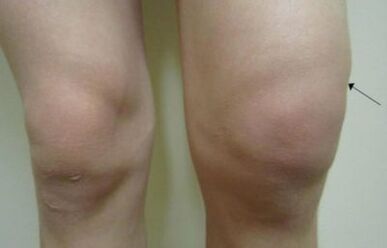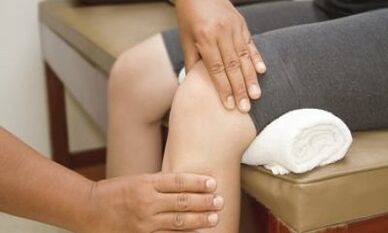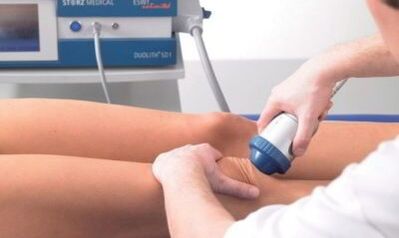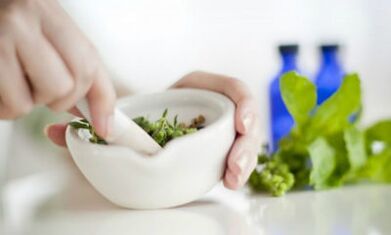Osteoarthritis or arthrosis of the knee joint is a disease that occurs against the background of dystrophic changes with the subsequent growth of the connective tissue.There are many factors that influence the development of the disease, but everyone ultimately leads to a violation of the metabolism in the cartilage.In medical literature, the osteoarthritis of the gonarthrosis knee joint is called.
According to statistics, gonarthrosis occupies a leading position with the frequency of occurrence in other osteoarthritis.The disease brings serious symptoms that can develop pain when walking and in peace.
Knowledge of the early symptoms will help to assume the development of the pathology and to heal them in the initial phases.
Reasons
According to medical classification, there is primary and secondary gonarthrosis or arthrosis of the knee joint.
Osteoarthritis of the knee joint can occur against the background of different diseases or act as their complication.If the exact cause cannot be determined on the basis of an unclear history or a clinical image, gonarthrosis is described as primary, but if the cause is known, such osteoarthritis is described as secondary.
Arthrosis develops with age with almost everyone, on average this time begins after 45-50 years of life.
The course and the pathogenesis of primary and secondary arthrosis are the same and do not depend on the cause of the occurrence.
The most common causes of osteoarthritis and arthrosis of the knee joint are:
- traumatic damage to the knee;
- Joint deformation internally and outside;
- Shortening of a lower limb;
- Abnormal hypermobility of the joint;
- Chondroblast dysplasia;
- Cartilage lime;
- Osteomyelitis of the femur and tibia;
- Rheumatoid arthritis or arthritis of any other etiology;
- Glucose metabolism;
- Metabolic diseases and hormonal diseases.
Injuries.After receiving the knee injury in the articular cavity, inflammation can develop with a large focus of the aliteration.After the disappearance of Pro -inflammatory active ingredients, the processes of reparation or osteoarthritis are activated.
Most of the time, the disease occurs against the background of a fracture with a break of the ligaments and damage to the bag and the cartilage surface of the joint.

Congenital deformations.Valgus or variores are found very often and can be complicated without proper correction by sclerotic changes in the knee.This happens due to the fact that one of the knees falls more than the load than it should be.
Shortening one of the lower extremities.In addition to deformations, the false distribution of weight on the knees plays the role in the pathogenesis of the development of the disease.
Hypermores of the knee.In this state, wear of the cartilage tissue of the knee joint with subsequent degeneration and degeneration in osteoarthritis can occur.Hypermorsion often leads to spontaneous transfers and sprains of the joint capsule.
Hand -haired dysplasia.Due to the improper development of the motor surface in the knee joint, pathological growth of the connective tissue occurs.
Calcinosis of the joint.The pathogenesis is based on the deposition of salts into the joint cavity and the formation of a specific precipitation, which causes calcification with subsequent osteoarthritis.
Osteomyelitis.Inflammatory bacterial diseases in which the destruction of bones and joints occurs.First, ankyloses and only then sclerosis are formed.
Arthritis of every etiology.Rheumatoid arthritis, accompanied by autoimmunlesions of the heart and the joints, are most dangerous.
Diabetes, like metabolic disorders, leads to a violation of the nutrient flow into the joint and sprout of the cartilage.
Obesity.With a great weight of the body, large loads are on the knees when walking and in a standing position.As a result of the constant pressure, the blood flow decreases to the knee lens and the atrophy with dystrophy arises.
Symptoms

Symptoms with arthrosis of the knee joint depend on the stage of the pathological process.Based on this, you can analyze the symptoms and pace of your growth and you can evaluate the expansion of the changes in the cartilage tissue.
Symptoms of knee arthrosis:
- The presence of pathological sounds during movement;
- Pain after load or calm;
- Reduction of functions;
- Edema and common climb;
- Pathological transfers, fractures and subluxation;
- Temporary jamming, which can occur when bending and extending the joint.
The click and crunch are not noticed immediately, and if you notice it, do not pay attention.Pathological sounds encounter the idea that a pathological process occurs with the storage of salts or the formation of osteophytes in the cartilage.
Pain occurs due to the formation of calculation or osteophytes.First of all, pain syndrome is not expressed, later it only appears in the morning and passes after lunch, with the progress of the disease, pain can occur in peace.
A decrease in the joint functions can be seen in the stiffness of movements and a decrease in their amplitude.Depending on the stage, the restriction of the movements can hold a certain time and pass in peace.
Edema occurs due to inflammation and hyperse secretion of the synovial fluid.There are also options when the skin is inflamed via the joints.Such symptoms can be with scarlet fever or rheumatism.
Transfer and subluxation occurs for the reason that the process for the bones and ligaments of the knee applies.
Buddy is a condition in which the movement in every axis is completely limited.Such a symptom shows the neglect of the process and the need for complex treatment.
Degree of arthrosis

Classify osteoarthritis according to the following signs:
- Radiological symptoms;
- Clinical manifestations;
- Labord data.
The most common and convenient classification is radiological, it is also easy and understandable for people without medical training.
Based on X rays, four degrees of arthrosis are differentiated in the knee joint:
- The reduction of the common gap is low and there are no osteophytes;
- The intermediate splitting is not lit, but there are signs of small calculation or osteophytes;
- The Interspinn Lücke has a narrowing expression, there are osteophytes that begins together;
- Lack of joint gap, bone formation, ankyloses and dystrophy.
The following phases are differentiated with regard to the clinical image:
- Light grade symptoms are insignificant, appear in the morning and pass 30-60 minutes after waking up.
- The average conclusion is a pronounced symptoms, the feeling of symptoms before lunch, the swelling is insignificant, it continues quickly without treatment.
- A serious degree - characterized by constant painful pain, discomfort in peace, morning stiffness only continues dinner, ankylose, burgis and sinusitis of the knee joint.
Laboratory tests are taken into account, the indicators of soy and leukocytes are evaluated.It is also necessary to check the presence of a rheumatoid factor.
Diagnostic methods
The diagnosis of osteoarthritis of the knee joint is not complicated, but requires certain skills of the doctor.
A distinction is made between two types of diagnostic measures:
- Laboratory diagnostics;
- Instrumental diagnostics.
For the correct diagnosis, each of the methods should be taken into account and analyze the image as a whole.
laboratory
If the arthrosis is suspected, the doctor present describes the following tests:
- General blood and urine test;
- Biochemical blood test;
- Determination of antibodies against the rheumatoid factor;
- Determination of antibodies against their own cells.
Labord data will not provide information about the development stage of the disease.
Instrumental

The instrumental diagnosis of osteoarthritis includes the following methods:
- Radiography in two standard projections;
- minimally invasive arthroscopy;
- UZD test;
- CT;
- MRI;
- Scintigraphy (according to information).
The radiation diagnostics aim to determine changes in the joint and to evaluate the cartilage state.
Treatment
Treatment of the arthrosis of the knee joint is a long process.The duration of the treatment is due to the fact that the reparation of cartilage tissue occurs very slowly, and in some cases it is completely impossible to restore the joint.
Modern methods for the treatment of osteoarthritis in the knee joint are comprehensive measures that aim to remove inflammation, the normalization of lifestyle and to improve the metabolism of cartilage tissue.
There are such therapy methods:
- Medicine therapy;
- Training therapy and massage;
- Folk medicine;
- Surgical interventions.
The doctor describes treatment due to the duration of the disease, the stage of its development and clinical manifestations.
Medication
The drug therapy aims to relieve pain and inflammatory reaction.The following drugs are prescribed for this purpose:
- non -steroidal anti -inflammatory anti -inflammatory;
- Chondroprotectors;
- Glucocorticoid;
- Cytostatic.
Tablets from the arthrosis of the knee joint have many side effects.During the treatment, it is necessary to monitor the condition of the stomach intestine tract and the kidneys.
Medicines for osteoarthritis are often prescribed for a long period of time, so that the least poisonous medication should be selected.
Exercises
The treatment of arthrosis using training therapy aims to strengthen the muscles and ligaments of the knee.With lectured loads in the cartilage of the diseased joint, metabolism improves and regenerative processes are accelerated.
Exercises should be selected individually taking into account the patient's stage and the patient's physical abilities.
massage
With the massage of the knee joint, you can improve blood flow and relieve symptoms.A proper massage can prevent the appearance of ankyloses and false joints.
People
The treatment of arthrosis of the knee joint at home should not be the main method to combat pathology or only act as a supplement to the medicine.

House treatment includes:
- Acceptance of body weight;
- Normalization of working hygiene and compliance with the day of the day;
- The fight against inflammation.
The anti -inflammatory effect is obsessed with such herbs:
- Tincture from Thyme and St. John's Wurt;
- Burdock leaves;
- white cabbage leaves;
- Infusions and decocements from dandelions and chamomile.
Operation
The operation is prescribed with the ineffectiveness of conservative therapy or at the patient's request.One of the main indications for the surgical intervention is the 4th stage of the disease through radiological features.
During operation, surgeons can completely replace the joint with an endoprosthesis or change one of its parts.

























